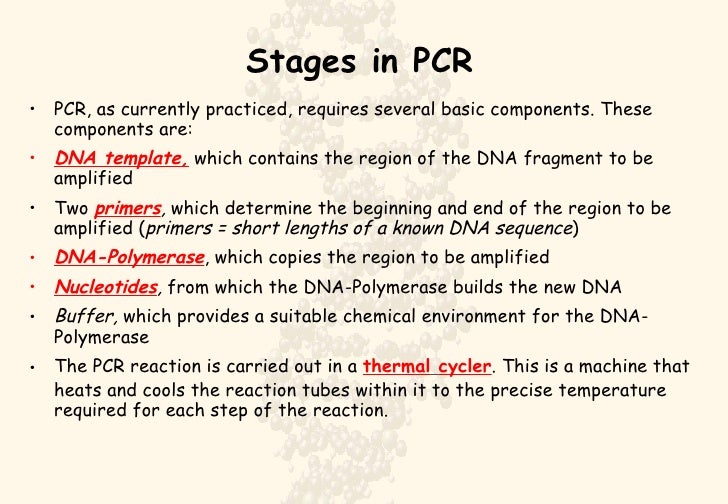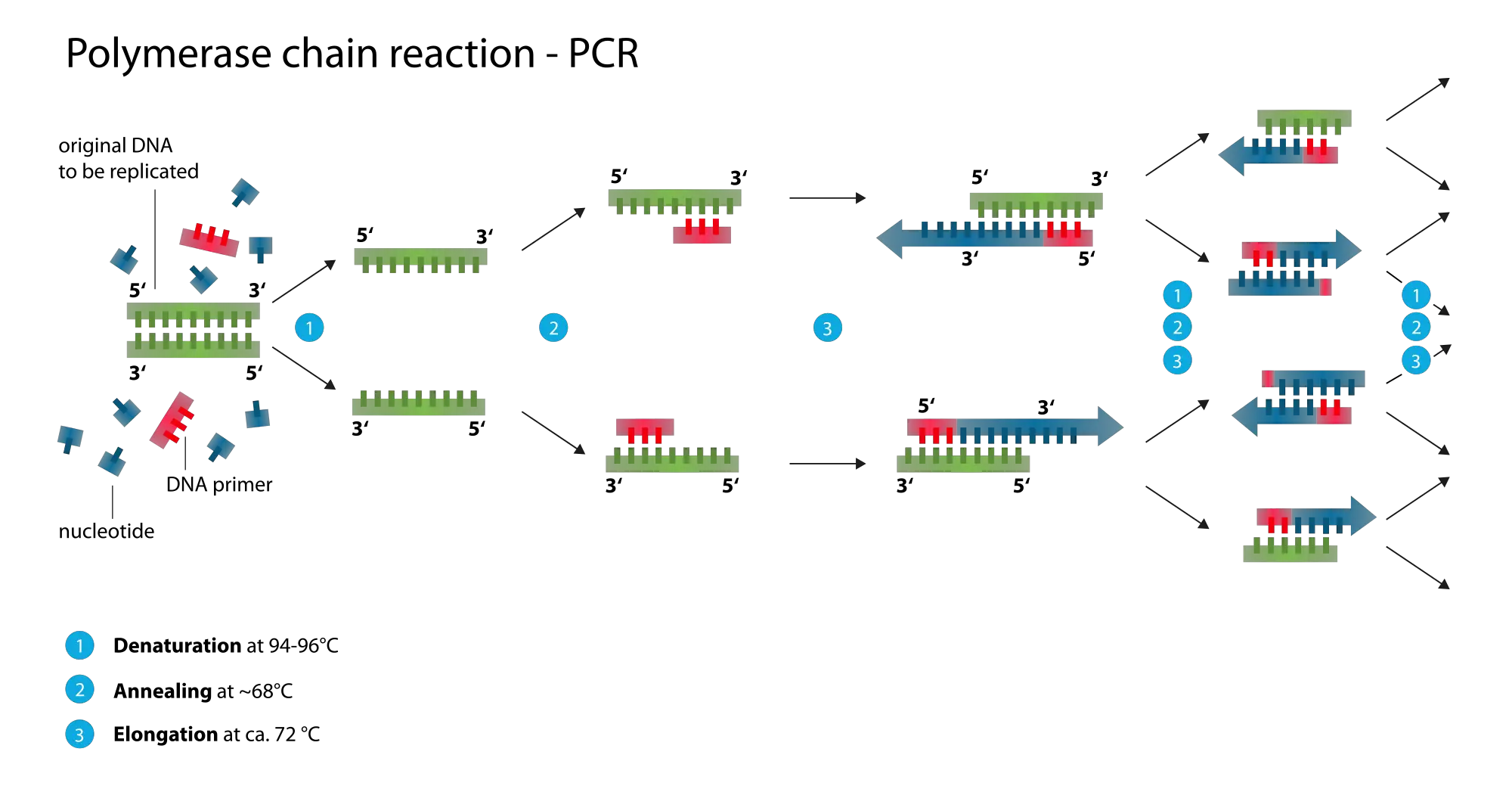41 label the steps and components of the polymerase chain reaction.
3 basic PCR steps of DNA amplification process - Biology Substantially, the primary purpose of polymerase chain reaction is to rapidly increase the number of copies of specific DNA regions. It consists of 3 basic PCR steps and a relatively complex reaction mixture. The product of the polymerase chain reaction acts as the means of further analysis. polymerase chain reaction | Definition & Steps | Britannica In the third step the temperature is raised to about 72 °C (162 °F), and the DNA polymerase begins adding nucleotides onto the ends of the annealed primers. At the end of the cycle, which lasts about five minutes, the temperature is raised and the process begins again. The number of copies doubles after each cycle.
Chemical Components of PCR | Polymerase Chain Reaction (PCR) - passel there are five chemical components needed, including a DNA template , DNA polymerase enzyme , primers, nucleotides and reaction buffer. These are described here in detail. 1. The DNA template is that particular DNA sequence which you want copied. 2. There are two requirements for a suitable DNA polymerase enzyme for PCR.

Label the steps and components of the polymerase chain reaction.
Polymerase Chain Reaction (PCR) : Principle, Procedure, Components ... This step involves heating the reaction mixture to 94°C for 15-30 seconds. During this, the double stranded DNA is denatured to single strands due to breakage in weak hydrogen bonds. Annealing : The reaction temperature is rapidly lowered to 54-60°C for 20-40 seconds. Research Techniques Made Simple: Polymerase Chain Reaction (PCR) The DNA polymerase is the key enzyme that links individual nucleotides together to form the PCR product. The nucleotides include the four bases - adenine, thymine, cytosine, and guanine (A, T, C, G) - that are found in DNA. These act as the building blocks that are used by the DNA polymerase to create the resultant PCR product. Polymerase Chain Reaction (PCR): Steps in This DNA Test PCR (polymerase chain reaction) is a method to analyze a short sequence of DNA (or RNA) even in samples containing only minute quantities of DNA or RNA. PCR is used to reproduce (amplify) selected sections of DNA or RNA. Previously, amplification of DNA involved cloning the segments of interest into vectors for expression in bacteria, and took ...
Label the steps and components of the polymerase chain reaction.. › US › enStandard PCR Protocol - Sigma-Aldrich A standard polymerase chain reaction (PCR) setup consists of four steps: Add required reagents or mastermix and template to PCR tubes. Mix and centrifuge. *Add mineral oil to prevent evaporation in a thermal cycler without a heated lid. Amplify per thermo cycler and primer parameters. Polymerase Chain Reaction - Sigma-Aldrich PCR consists of cycles of reaction heating and cooling. Each temperature plateau is used to control a defined stage of the reaction and the incubation times are dependent on the instrument, reaction plates or tubes and reagents. These should be optimized for each experiment, especially if increased detection sensitivity is required 5. PCR - Amplifying DNA | Ask A Biologist Taq polymerase catalyzes the generation of new pieces of ssDNA that are complimentary to the portions marked by the primers. The job of Taq polymerase is to move along the strand of DNA and use it as a template for assembling a new strand that is complimentary to the template. This is the chain reaction in the name polymerase chain reaction. Polymerase Chain Reaction - an overview | ScienceDirect Topics (in PCR) The first step of each PCR cycle where the thermocycler temperature is high enough to "melt" the hydrogen bonds holding double-stranded DNA together, and resulting in single-stranded DNA. directed mutagenesis Deliberate alteration of the DNA sequence of a gene by any of a variety of artificial techniques. elongation
PDF Polymerase Chain Reaction - Milwaukee School of Engineering The above-mentioned components are mixed in a test tube or 96-well plate and then placed in a machine that allows repeated cycles of DNA amplification to occur in three basic steps. The machine—essentially a thermal cycler—has a ther - mal block with holes into which the test tubes or plates hold-ing the PCR reaction mixture are inserted. Polymerase chain reaction (PCR) (article) | Khan Academy The steps of PCR The key ingredients of a PCR reaction are Taq polymerase, primers, template DNA, and nucleotides (DNA building blocks). The ingredients are assembled in a tube, along with cofactors needed by the enzyme, and are put through repeated cycles of heating and cooling that allow DNA to be synthesized. The basic steps are: Steps in the Polymerase Chain Reaction - Study.com The denaturation step breaks hydrogen bonds using heat. The denaturation step performs the same function as RNA primase does during DNA replication. An enzyme is required to accomplish the... Polymerase Chain Reaction - MyBioSource Learning Center The PCR reaction begins with a high temperature of 94-98 °C for an extended period of 1-9 minutes to activate the heat stable DNA polymerase. This step is followed by holding the temperature to .94-98 °C for 20-30 seconds.
Polymerase chain reaction : basic protocols - PubMed The melding of a technique for repeated rounds of DNA synthesis with the discovery of a thermostable DNA polymerase has given scientists the very powerful technique known as polymerase chain reaction (PCR). PCR is based on three simple steps required for any DNA synthesis reaction: (1) denaturation … What Are the Steps in PCR? - Reference.com A polymerase chain reaction, or PCR, consists of three steps: DNA denaturation, primer annealing and extension. These steps are repeated between 20 and 35 times to synthesize the correct quantity of the DNA of interest. Each of these steps requires a different temperature range, which allows PCR machines to control the steps. PCR is typically done in small PCR reaction tubes containing all the ... Polymerase Chain Reaction: Basic Protocol Plus Troubleshooting and ... The three temperature steps in a single cycle accomplish three tasks: the first step denatures the template (and in later cycles, the amplicons as well), the second step allows optimal annealing of primers, and the third step permits the DNA polymerase to bind to the DNA template and synthesize the PCR product. › polymerase-chain-reactionPolymerase Chain Reaction - an overview | ScienceDirect Topics The polymerase chain reaction (PCR) is a basic molecular technique used for amplifying target sequences from a DNA template in an exponential manner. This is accomplished by using thermal cycling, a process in which a solution that includes DNA is repeatedly heated and cooled in order to (1) melt the DNA, (2) anneal short DNA fragments called ...
Microbiology - Mastering Microbiology Homework Chapter 8 ... - Quizlet Chapter 8 Figure 1 - You will identify the steps and components of the polymerase chain reaction. (See image above.) Label the steps and components of the polymerase chain reaction. Drag the appropriate labels to their respective targets. (See image above.) Sets found in the same folder.
PDF Polymerase Chain Reaction (PCR) - G-Biosciences All components used in the polymerase chain reaction should be kept on ice.The students experiments should all be carried out on ice. 2. Transfer 150P l Sterile Water to the 5 Genomic Primer tube.Resuspend the primer by gently pipetting up and down. 3. Label six tubes with 5 Primer .
› cpb › medicalPolymerase Chain Reaction Testing: Selected Indications The development of the polymerase chain reaction (PCR) has greatly simplified DNA analysis and shortened laboratory time (ACOG, 2002). Polymerase chain reaction allows the exponential amplification of the targeted gene or DNA sequence. Only minute quantities of DNA, typically 0.1 to 1.0 mg, are necessary for PCR.
› pmc › articlesRecombinase polymerase amplification: Basics, applications ... Oct 26, 2017 · 1. Introduction. The 1953 discovery of the structure of DNA ushered a revolution in molecular biology, leading to an increased understanding of the central dogma and the subsequent development of invaluable molecular biology techniques, including the polymerase chain reaction (PCR), electrophoresis and automated sequencing, culminating in the completion of the human genome project (HGP) in 2003.
Steps Involved in Polymerase Chain Reaction in DNA Sequence PGR is a three-step process or cycle. It is repeated a specified number of times. Once PGR cycle is comprised of these steps namely Denaturation, Annealing and Extension.
Solved 3' 3' | Chegg.com Expert Answer 100% (2 ratings) PCR is polymerase chain reaction. It is a chain of three reactions, which occur one after the other and lead to the amplification of gene of interest. The first step in PCR is denaturation. It occurs at a temperature of around 90 degree ce … View the full answer Transcribed image text: 3' 3'
The Polymerase Chain Reaction (With Diagram) Let us make an in-depth study of the polymerase chain reaction, which is a technique for amplifying DNA sequences. The below given article will help you to understand the following things:- 1. Polymerase Chain Reaction Amplifies Specific Regions of DNA 2. Performing a Polymerase Chain Reaction 3.
PCR: Reagents Used in Polymerase Chain Reaction - Study.com Polymerase Chain Reaction. Professor Pear: PCR stands for polymerase chain reaction.It's a laboratory procedure that can be used to create copies of DNA. It's basically an artificial version of ...
› pcr-process-steps-explainedPCR Process Steps Explained - Cole-Parmer May 31, 2022 · DNA polymerase: an enzyme that aids in the synthesis of a complementary strand of DNA ; Nucleotide solution mix containing adenine (A), thymidine (T), cytosine (C), and guanine (G) used to build duplicate DNA strands; PCR process steps. The PCR process has 4 steps:collection, preparation, amplification, and post PCR clean-up. The PCR machine ...






Post a Comment for "41 label the steps and components of the polymerase chain reaction."